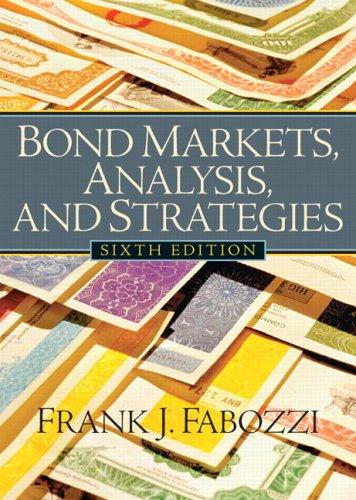e. Mr. Clark is considering another bond, Bond D. It has an 8% semiannual coupon and a $1,000 face value (i.e., it pays a $40 coupon every 6 months). Bond D is scheduled to mature in 9 years and has a price of $1,150. It is also callable in 5 years at a call price of $1,040. 1. What is the bond's nominal yield to maturity? Round your answer to two decimal places. % 2. What is the bond's nominal yield to call? Round your answer to two decimal places. % 3. If Mr. Clark were to purchase this bond, would he be more likely to receive the yield to maturity or yield to call? Explain your answer. the YTC, Mr. Clark expect the bond to be called. Consequently, Because the YTM is he would earn f. Explain briefly the difference between price risk and reinvestment risk. This risk of a decline in bond values due to an increase in interest rates is called income decline due to a drop in interest rates is called Which of the following bonds has the most price risk? Which has the most reinvestment risk? .A 1-year bond with a 7% annual coupon A 5-year bond with a 7% annual coupon. A 5-year bond with a zero coupon A 10-year bond with a 7% annual coupon. A 10-year bond with a zero coupon has the most price risk. has the most reinvestment risk. A A The risk of an g. Calculate the price of each bond (A, B, and C) at the end of each year until maturity, assuming interest rates remain constant. Round your answers to the nearest cent. Years Remaining Until Maturity Bond A Bond B Bond C 12 11 10 9 8 7 6 5 4 $ $ $ $ $ $ $ $ $ $ 3 $ $ $ $ $ $ $ $ 2 $ $ 1 $ $ 0 $ $ Create a graph showing the time path of each bond's value. Choose the correct graph. The correct graph is $ $ $ $ $ $ $ $ $ $ $ A. Bond Value C. Bond Value $1,400 $1,200- $1,000 $800- $600 $400 $200- $0 12 $1,400 $1,200- $1,000 $800- $600 $400 $200 Time Paths of Bonds A, B, and C. Years Remaining Until Maturity Bond B Time Paths of Bonds A, B, and C Bond A Bond C 0 B. D. Bond Value Bond Value $1,400 $1,200- $1,000 $800 $600 $400 $200 $0 12 $1,400- $1,200- $1,000- $800 $600 $400 $200 Time Paths of Bonds A, B, and C Years Remaining Until Maturity Bond B Time Paths of Bonds A, B, and C 9 Bond A Bond C 1. What is the expected current yield for each bond in each year? Round your answers to two decimal places. Years Remaining Until Maturity Bond A Bond B Bond C 12 % % % 11 % % % 10 % % % % % 9 % % % 8 % % % % % % % % % % % % % % % % % % % % % % 2 What in a 7 6 -NW Sa 5 4 3 2 1 2. What is the expected capital gains yield for each bond in each year? Round your answers to two decimal places. Years Remaining Bond B Bond C Until Maturity Bond A % % % 12 % % % 11 % 10 % % % % % 9 % % % % % % % % % % % % % 8 7 6 5 4 3 21 % % % % % % L L L L & % % % % % 3. What is the total return for each bond in each year? Round your answers to two decimal places. Years Remaining Bond C Until Maturity Bond A Bond B % % 12 % % 11 % % 10 % % 9 % % 8 % % 7 % % 6 % % % % % % % % % % DI 321 5 4 Le Le Le Le Le % % % % % % % Le Le Le Le L % % % % %













